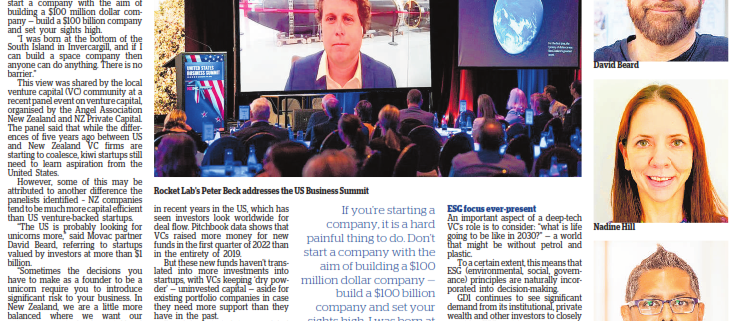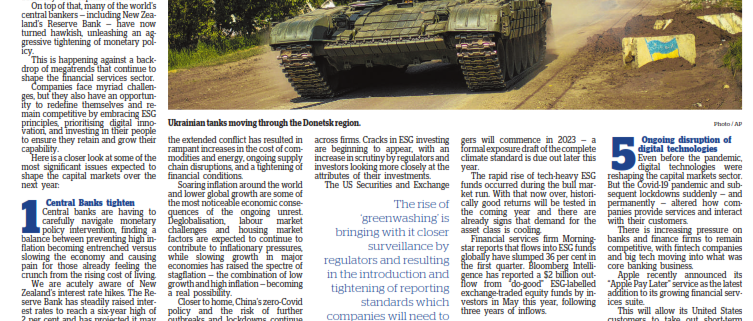Surviving the Bears: Optimism in venture capital
Surviving the Bears: Optimism in venture capital
At the recent US Business Summit, Rocket Lab’s Peter Beck told the audience that the number one problem New Zealand entrepreneurs have is they don’t think big enough.
“Think bigger. Way, way bigger,” he urged. “If you’re starting a company, it is a hard painful thing to do. Don’t start a company with the aim of building a $100 million dollar company — build a $100 billion company and set your sights high.
“I was born at the bottom of the South Island in Invercargill, and if I can build a space company then anyone can do anything. There is no barrier.”
This view was shared by the local venture capital (VC) community at a recent panel event on venture capital, organised by the Angel Association New Zealand and NZ Private Capital. The panel said that while the differences of five years ago between the US and New Zealand VC firms are starting to coalesce, kiwi startups still need to learn aspirations from the United States.
However, some of this may be attributed to another difference the panellists identified – NZ companies tend to be much more capital efficient than US venture-backed startups.
“The US is probably looking for unicorns more,” said Movac partner David Beard, referring to startups valued by investors at more than $1 billion.
“Sometimes the decisions you have to make as a founder to be a unicorn require you to introduce significant risk to your business. In New Zealand, we are a little more balanced where we want our entrepreneurs at a fundamental level to succeed and work out what the measured risk is instead.”
The state of the economy
Given the current economic climate, operating as a VC in a bear market inevitably took centre stage at the panel discussion.
Beard explained that the nature of VC investing means that the current climate is negligible since investments, whether they were made over the past two years or will be made in the coming years, would not be realised until an initial public offering (IPO) or sale in a bull market.
“We might have a two-year hiccup, which will see a shift in mode setting from ‘growth at any cost’ to ‘growth with some efficiency around it’,” he said. “Founders and venture capital firms will need to make sure that they are making the best use of the money they have for the next couple of years — it’s about being a bit more sensible.”
A lot of big funds have been raised in recent years in the US, which has seen investors look worldwide for deal flow. Pitchbook data shows that VCs raised more money for new funds in the first quarter of 2022 than in the entirety of 2019.
But these new funds haven’t translated into more investments into startups, with VCs keeping ‘dry powder’ — uninvested capital — aside for existing portfolio companies in case they need more support than they have in the past.
Beard has started to see global funds retract. “We need to make sure we have companies we can fund in New Zealand through co-investment, and make sure the good ones get the resources and money they need over the next few years,” he said.
“Expectations of wildly growing high valuations and selling in three years might have been possible recently, but now we need to be more pragmatic.”
Punakaiki Fund’s Nadine Hill told the audience that the inflationary environment will provide fuel to help accelerate change.
“We saw in Covid how important technology solutions were for people. With inflation, it has never been more important to take costs out of business, and do business and life better,” she said. “We are not traders, we’re not trying to buy low and sell high, we are trying to build companies over the longer-term.”
GD1’s founding partner Chintaka Ranatunga shared this sentiment. While the next three years will likely see a higher failure rate among early-stage startups than in recent years, he also expects to see the creation of exciting new companies.
“This kind of environment is a great time to start something, we will see companies become stronger and have better access to talent,” he said. “Despite the doom and gloom, I am optimistic about the three-year outlook — remembering that for most of us it is a 10-year game, rather than a short-term one.”
ESG focus ever-present
An important aspect of a deep-tech VC’s role is to consider: “what is life going to be like in 2030?” — a world that might be without petrol and plastic.
To a certain extent, this means that ESG (environmental, social, governance) principles are naturally incorporated into decision-making.
GD1 continues to see significant demand from its institutional, private wealth and other investors to closely consider ESG metrics.
“We have a bunch of exclusionary criteria around sectors, along with ESG and diversity clauses in our term sheets,” said Ranatunga, with GD1 actively working on requirements for companies to report back.
Pacific Channel’s Kieran Jina said that investors in his deep-tech VC ultimately want to invest in things that will make them feel good.
“If you have a company that adheres to ESG principles, it is more likely to meet that requirement.”
But he acknowledges the increasing concerns of greenwashing and accurate reporting of ESG metrics.
“Measuring is always going to be problematic, and it can become very subjective,” he said.
“The harder aspect has been in the governance area.
“A lot of companies that come to us haven’t necessarily thought about that — if we applied a negative filter to our decision-making then there wouldn’t be a pipeline left.”


